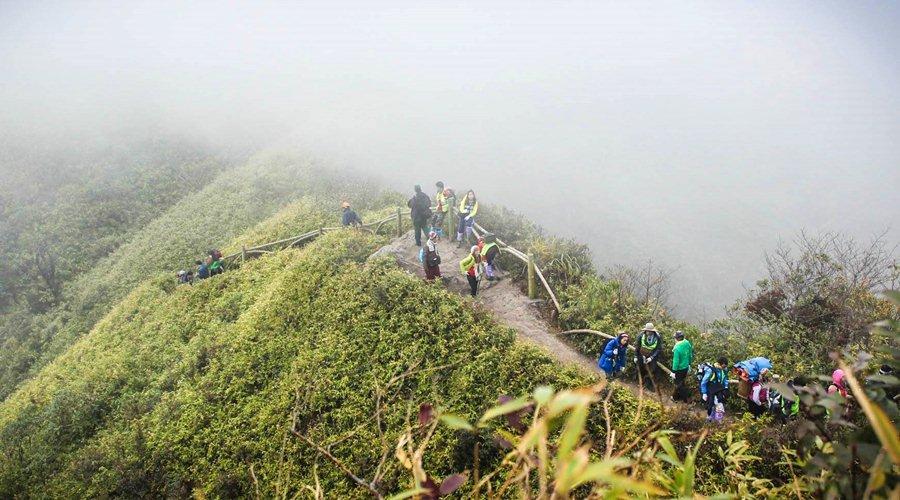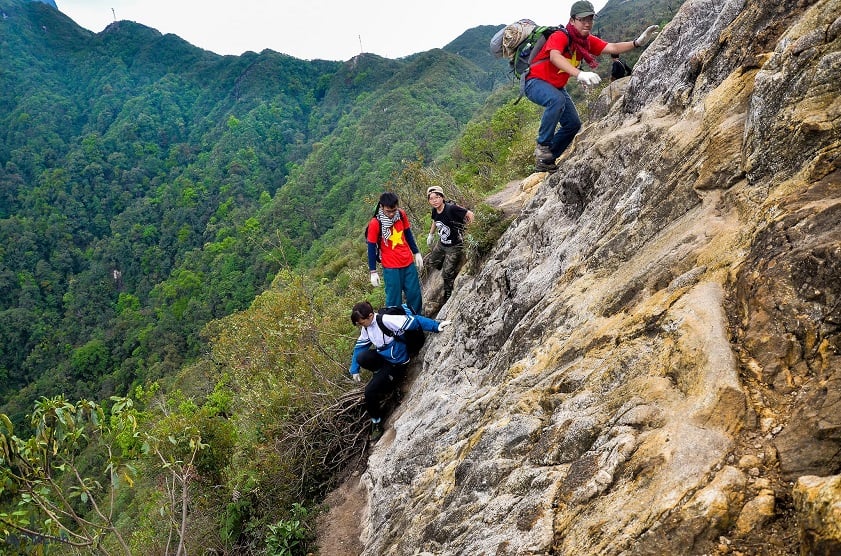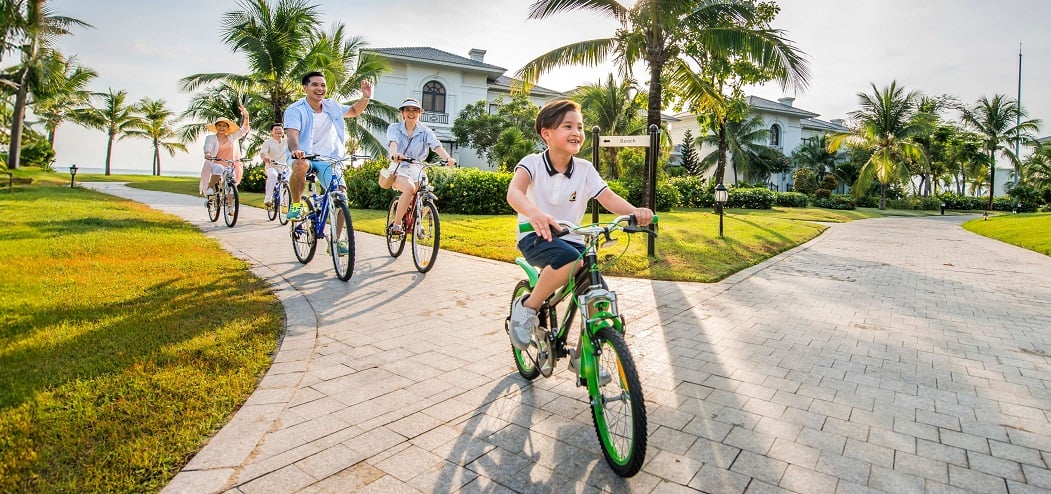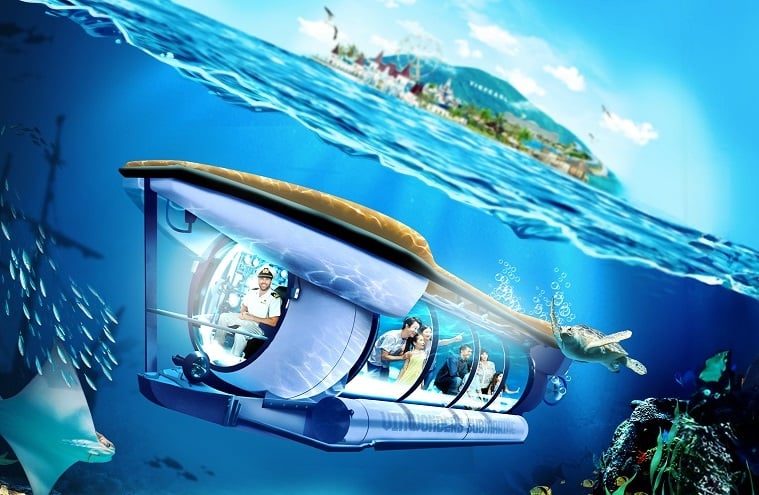
This ultimate guide is crafted to ensure your adventure is not just memorable but trouble-free, providing invaluable insights into the challenging yet rewarding world of Fansipan trekking. Here, we will unveil the secrets of Fansipan Mountain, the crown jewel of the Indochina Peninsula, while you explore the trails of Sapa trekking.
1. Reasons why you should go Fansipan trekking
Fansipan mountain trekking is a compelling adventure for those seeking an exhilarating experience, offering a unique blend of natural wonder and cultural immersion. This mountain boasts an impressive height of 3,143 meters and is part of Hoang Lien Son Mountain, situated approximately 9 kilometers southwest of the town of Sapa.
The journey to the summit of Fansipan, the highest peak in the Indochina Peninsula, unveils breathtaking landscapes, ranging from terraced rice fields to enchanting forests. The allure of Hoang Lien Son Mountain surrounding Fansipan adds an extra layer of splendor to the trek, with mist-shrouded peaks and diverse ecosystems creating a visual feast for every trekker.
Beyond the stunning vistas, Fansipan trekking provides an opportunity to connect with the local ethnic communities, offering a deeper understanding of the rich cultural tapestry of the region. In addition to Fansipan itself, visitors can also admire the statue of Buddha Amitabha - a Buddhist monument located at the highest point in Vietnam.

2. When is the best time for Fansipan trekking?
The best time for Fansipan mountain trekking is determined by the characteristics of Fansipan weather. Generally, it is between late September and mid-December, when you can enjoy the amazing views here in their entirety. During these months, Fansipan has cooler weather and clear skies, which are best suited for such an expedition. Spring also provides good weather with blooming flowers that give color to the beautiful surroundings.
However, it is essential to be aware that the mountain's high elevation can contribute to unpredictable conditions. The summer months from June to August bring warmer temperatures but are accompanied by increased rainfall, making the trails slippery. Therefore, to ensure a safe Fansipan trekking experience, the autumn months remain a prime choice for avid trekkers and nature enthusiasts alike.

>>> More on: Sapa weather and seasonal characteristics to know before traveling
3. Popular Fansipan trekking routes
Fansipan mountain trekking typically offers three routes, each with varied terrains and distances. They are:
- From Tram Ton Pass
This route is preferred by most people and is a good option for those with an ordinary level of fitness. You will begin from a height of 1,900 meters at the pass, then trek into the forest. The first part, taking approximately 6 hours, will take you to 2,200 meters above sea level. The second part will have you ascend to a rest point 2,800 meters high before you reach the peak of Fansipan. The beauty of nature along this route is plain and simple. This trek can be done in 2 days and 1 night or even just one day for those who are used to mountaineering.
- From Sin Chai Village
This is an extremely hard hike that should be attempted by fit mountain climbers with experience only. This route is going to be more scenic, as there will be a variety of beautiful landscapes to behold in the mountains. From Sin Chai Village, you will start at an altitude of 2,200 meters to ascend Fansipan’s summit at the 2,800-meter elevation. This trail can take more than two days and one night for trekkers to finish.
- From Cat Cat Village
This is the most captivating and also the hardest trail, fitting only experienced mountain climbers that are passionate. Beginning from Cat Cat Valley up to Tram Ton or Sin Chai, then you can climb towards the peak itself. This route offers a unique adventure through many charming environments. Completing this route usually takes 3 days and 2 nights or more.

>>> Read more: How to get to Sapa from other places in and outside Vietnam: A quick guide
4. Are there any difficulties in Fansipan mountain trekking?
Fansipan trekking poses certain challenges, and the difficulty levels will vary based on the chosen route.
4.1. From Tram Ton Pass and Sin Chai Village
Trekking from Tram Ton Pass involves ascending using ropes from the 2,700-meter mark, demanding both physical strength and mountaineering experience. From the 2,800-meter mark to the 2,900-meter mark, your trek will take place in a bamboo forest with lots of steep slopes. Some parts even require the use of iron ladders. From here, climbing to the 3,000-meter mark involves trekking through a dwarf bamboo forest along a trail with railing, climbing steep cliffs, and finally wading through 100 meters of marshy ground before reaching the top of Fansipan. Trekkers should be extra careful while climbing from the 2,600-meter mark to the 3,000-meter mark in the windy and rainy weather.
4.2. From Cat Cat Village
This is the longest route, so trekkers need high physical endurance. You will traverse low mountains, weave through forests, and climb waterfalls to reach the peaks. From the second day at the altitude of 1,800 meters, this Fansipan mountain trekking route will have you climb a vertical waterfall and slippery boulders. Climbing these rocks is essential to reach the 2,000-meter mark. Then, you will pass through many streams that become fierce rivers during the rainy season. At the height of 2,000 meters, trekkers will continue the journey by grabbing the roots of massive ancient trees. The forest is very muddy, where the ground is blanketed by rotten leaves.

5. How much does a Fansipan trekking tour cost?
The price of a Fansipan trekking tour in Sapa depends on whether it is short or long, whether there are many or few people involved, and whether extra service or equipment is required. For a Fansipan mountain trekking tour that lasts for two days and one night, you can expect a price at around 3,500,000 VND. A tour that lasts for three days and two nights may cost 4,100,000 VND.
6. What to prepare for a Fansipan mountain trekking tour?
Embarking on a Fansipan mountain trekking tour necessitates thorough preparation to ensure a safe and enjoyable adventure.
6.1. Good physical condition
Ensuring optimal fitness is paramount for a successful Fansipan trekking experience. Endurance and strength are necessary when tackling these tough terrains. As this is not a venture that everybody should take, it is mostly suitable for those who are spirited, challenge-loving, and fond of climbing mountains. Those planning to embark on Fansipan mountain trekking should seek out advice from their doctors first. Those with poor conditions, such as those suffering from chronic diseases, should avoid this trek altogether.
One or two weeks before the trek, it is prudent to conduct a regimen of physical training. Spend an hour walking, climbing stairs, and running while putting on a backpack that weighs 5 kg. These exercises will improve your capabilities so that you can be ready for the upcoming Fansipan trekking tour. And don’t forget to warm up before the trek to avoid injuries while mountaineering.

6.2. Appropriate clothes, trekking equipment & other essentials
Preparing the right clothes and equipment are a must. Bring a variety of appropriate garments for trekking such as sweat-absorbent layers, waterproof jackets, and tough hiking shoes. Necessary items for Fansipan mountain trekking include a backpack, trekking poles, a hat, sunglasses, a reliable water-bottle. You should also bring a first aid kit, sunscreen, insect repellent, and a headlamp.
Fansipan trekkers need boots with good grip. Long knee socks are required to avoid rock scraping as well as insect bites. Cleated boots provide excellent traction. It is advisable to choose a boot size that is slightly larger than your foot, accounting for the thickness of the socks and potential foot swelling later in the day. Choose a lightweight backpack made out of sturdy fabric with a waterproof cover. Chocolate, dried fruits, and water are essential provisions.
Meticulous preparations are even more important for difficult routes. Use a GPS navigational tool to track your steps so you can backtrack if you get lost. It is also beneficial to have a two-way radio in the high mountain areas, where phone signals may be weak.

6.3. An experienced porter
Every expedition should be guided by a trustworthy partner. Therefore, it is best to have someone in the group who has climbed Fansipan before who will act as a guide. You can also hire a knowledgeable tour guide among the locals.
While on the trek, you should be assisted by porters (who are mostly from the local ethnic community) who will help with carrying baggage and setting up tents. They are tough, jovial, and familiar with the paths that lead up to the peak of Fansipan.
The local porter usually doubles as a tour guide. Don’t hesitate to inquire with them about whatever you need concerning Fansipan trekking. Their experience and familiarity with the terrain make them invaluable companions for your mountain ascent.
6.4. An official entry permit for Hoang Lien National Park
Acquiring an official permit for entry to Hoang Lien National Park is mandatory. You will need to go to Hoang Lien Center of Eco-tourism and Environmental Education to acquire approvals before commencing the trek. This center is down the road to Cat Cat Village. In addition, you will be required to make additional payments for insurance, sanitation, supervision, accommodation, etc. If you are part of a guided tour, this permit is typically arranged by the tour operators and ensures compliance with the park’s regulations.

Beside Fansipan mountain trekking, you can also explore other enticing trekking destinations in Sapa such as Ham Rong Mountain, Ta Phin Village, Y Linh Ho Village, Lao Chai Village, etc. These locations all offer unique experiences and picturesque landscapes for trekking enthusiasts.
After exploring Sapa, for a broader Vietnam travel journey, consider visiting iconic cities like Hanoi, Ho Chi Minh City, Phu Quoc, Nha Trang, Hoi An, Ha Long, etc. For luxurious accommodation in these cities, you can consider staying at Vinpearl’s resorts and hotels. Vinpearl boasts state-of-the-art facilities, including lavish spas, gourmet dining options, and extensive recreational activities. The Vinpearl experience is designed to provide guests with a perfect blend of comfort, luxury, and relaxation.
Moreover, don't miss the chance to explore the entertainment haven of VinWonders, which features thrilling games, captivating shows, and immersive experiences. VinWonders is an ideal destination for families and adventure seekers alike.

>>> Book rooms in Vinpearl Phu Quoc, Vinpearl Nha Trang, Vinpearl Resort & Golf Nam Hoi An, Vinpearl Resort & Spa Ha Long for a luxury stay!
Fansipan trekking is an exhilarating journey through the breathtaking landscapes of Sapa. The majestic Fansipan Mountain, standing as the pinnacle of the Indochina Peninsula, beckons adventurers to conquer its peaks. Whether scaling rocky terrains or traversing bamboo forests, Fansipan mountain trekking brings a test of endurance, offering an unforgettable adventure for those seeking the thrill of conquering new heights.
























